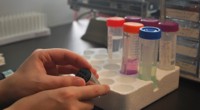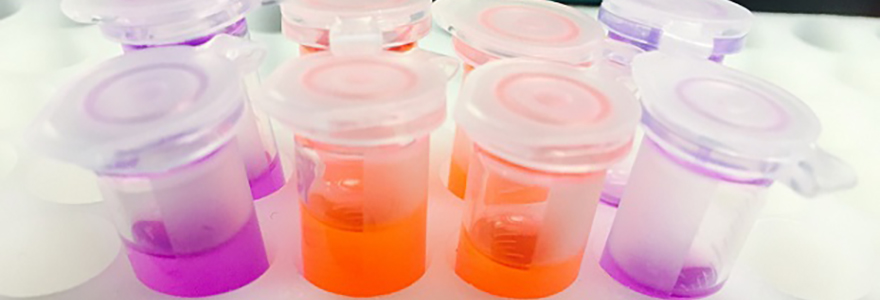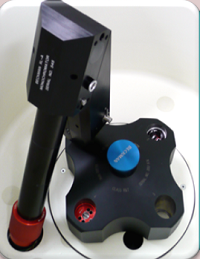Protocols
BICF is one of the six core facilities of the LRPC.

Protocols

Sample Preparation, Cuvettes and Buffer Selection
Each instrument in the BICF requires a different method of sample preparation. For a detailed description, questions or to book a meeting to discuss this topic, please contact the facility manager.
As with any new method, you will have the greatest chance of success if you are well-prepared. Read up on the theory behind the technique; you will get more out of the training sessions and remember the protocols better if you understand what you are doing in advance.
We will be happy to recommend some background reading material and to address any concerns you may have about the methods before you begin experimentation.
Analytical Ultracentrifugation
 For sedimentation equilibrium, you should prepare at least 350uL of sample. For sedimentation velocity, prepare at least 400uL. Aim for a concentration that will put you in the absorbance range of approximately 0.15 to 0.5 AU for equilibrium and 0.15 to 0.8 AU for velocity. Note: New! We now have shorter pathlength centerpieces if you need to work at higher concentrations, requiring about a third of the volumes previously mentioned. Absorbance range recommendations are the same.
For sedimentation equilibrium, you should prepare at least 350uL of sample. For sedimentation velocity, prepare at least 400uL. Aim for a concentration that will put you in the absorbance range of approximately 0.15 to 0.5 AU for equilibrium and 0.15 to 0.8 AU for velocity. Note: New! We now have shorter pathlength centerpieces if you need to work at higher concentrations, requiring about a third of the volumes previously mentioned. Absorbance range recommendations are the same.
Remember to calculate your partial specific volume (v-bar) and density (rho) values ahead of time so that you can easily process your data immediately. Need help getting these values? Download SEDNTERP for quick and easy calculations of these values.
Circular Dichroism Spectropolarimeter
The choice of buffer in CD experiments is critical. UV transparency is your first goal—since most structural information of interest is found in the lower UV range. As you may imagine, a high absorbance of some buffers will introduce noise and mask the protein’s CD signals.
Buffer Composition:
- You must use a buffer that is UV transparent.
- Do not use NaCl. If a counter ion is needed, use Na2SO4, KF or NaF.
- Dithiothreitol (DTT), 2-mercaptoethanol and EDTA can be used in low concentrations.
- Additives that aid in solubility such as glycerol can be used, providing they are UV transparent.
Sample Volume:
For 1mm cell, approximately 300uL is needed.
For 0.1mm cell, approximately 50uL;
For 10mm cell, approximately 3-4 mL required.
Sample Concentration:
A good starting point—Plan to use the 1mm cuvette, and prepare your protein to a concentration that will give you an A280 of ~1.0. If you choose to use the 0.1mm cuvette, you will need a higher concentration of protein (but smaller volume), and for the 10mm cuvette, you will need a lower concentration of protein (but larger volume).
Data Analysis: Once you've collected your spectra and converted it to mean residue ellipticity units, to analyze and predict secondary structure folds you can download the CDPro software suite.
Fluorometer
Minimal sample preparation required. For our cuvettes (quartz reusable or single-use Acryl disposal cuvettes) we require a sample volume of 600uL to 4mL. It is recommended that you bring extra buffer should it be necessary to dilute your sample.
Isothermal Titration Calorimeter
Since ITC measures heat evolution/absorption upon injecting aliquots of one reactant into the other in the sample cell, it is absolutely imperative that the solution in the sample cell (usually the protein) and solution of titrant be in the same buffer (or, at the very least-- at the exact same pH), this way all thermogram signals will be solely due to the heats released upon binding or dissociation.
Sample Volume
Prepare approximately:
2 mL of your protein solution, and
600 uL of your titrant.
Sample Concentrations
For first time users with no idea of their Kd, try starting with:
~10uM protein sample, and
~100uM titrant.
*Note that if you have a weak Kd, this might not be sufficient concentration to see any binding. If you suspect only a weak interaction will be present, you will have to largely increase these values.
Differential Scanning Calorimeter
While the reaction cell itself only holds approximately 0.6 mL, it is a good idea to prepare about 1 mL of your protein sample to leave room for a little sample loss upon loading. Remember to bring along a few millilitres of the buffer your protein is in, as that will be used for rinsing, initial buffer-buffer scans, and during the actual experiment in the reference cell.
It is a good idea to spin down or filter your samples before injecting them into the DSC. Syringes and filters will be provided if necessary.
Dynamic Light Scattering Instrument
Only about 10uL of sample is needed for a DLS experiment, however it is important that no dust or particulate matter is present in solution as this will cause large fluctuations in the scattering signal which will ultimately lead to inconsistent or erroneous results. Therefore, be sure to spin down or filter your sample through a small pore size before using it. For no extra charge, we will provide the cuvette, syringe and 0.02um or 0.1um filters if necessary. It is a good idea to bring some extra buffer in case the sample needs to be diluted.








